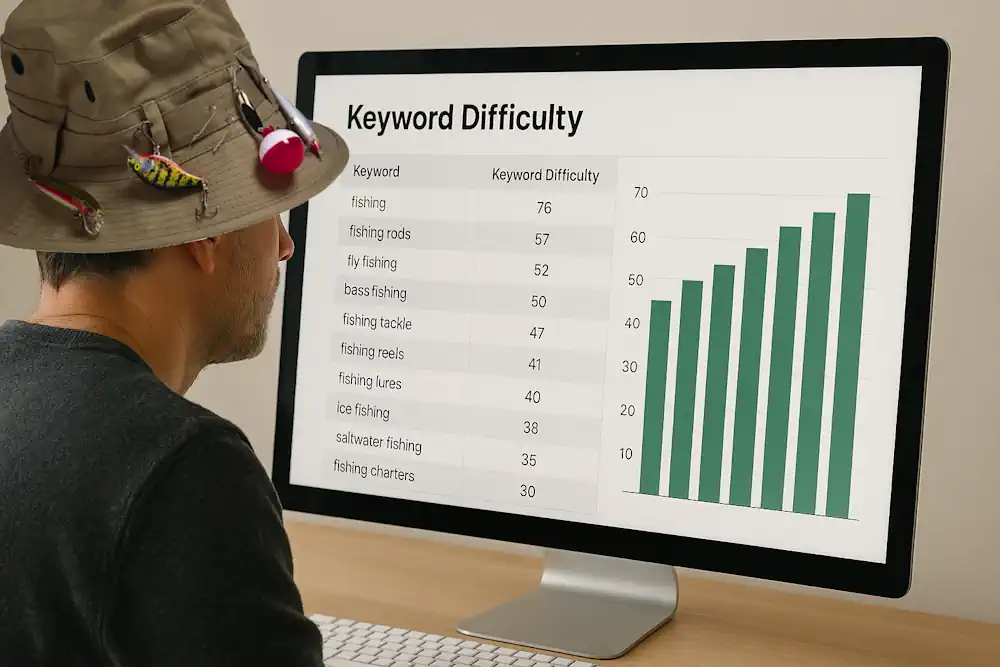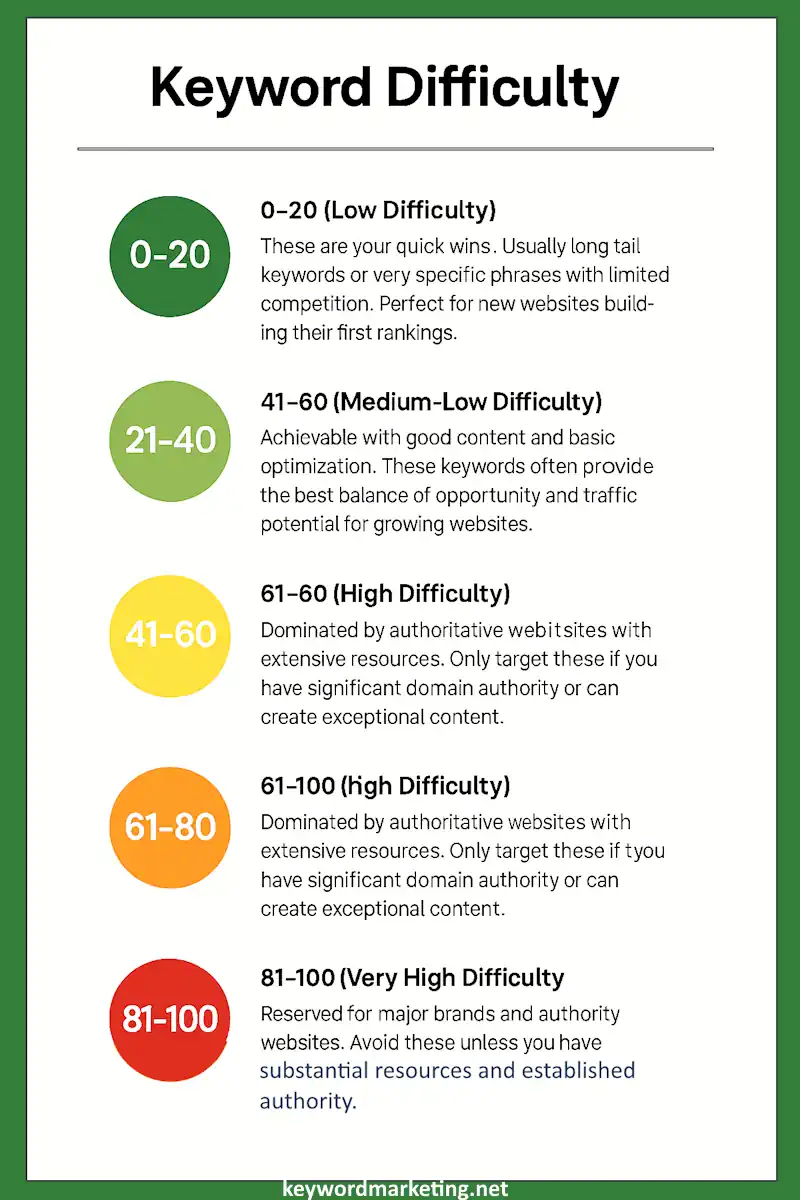When you’re starting with keyword research, one of the most important numbers you’ll encounter is the keyword difficulty score. This single metric can save you months of wasted effort by helping you choose keywords you can actually rank for.

Think of keyword difficulty as a competitive assessment. Just like you wouldn’t expect to win a marathon without training, you shouldn’t expect to rank for highly competitive keywords without the right foundation. Understanding difficulty scores helps you pick battles you can win.
What Keyword Difficulty Really Tells You
A keyword difficulty score measures how challenging it would be to rank on the first page of search results for a specific keyword. Most tools use a scale from 0 to 100, where 0 means virtually no competition and 100 means extremely difficult to rank.
But here’s what many beginners miss: difficulty isn’t just about competition. It reflects multiple factors, including how many websites are targeting that keyword, how authoritative those websites are, and how well-optimized their content is. A keyword with a difficulty score of 80 generally means you’re competing against established, well-optimized websites with strong authority.
The factors that can influence the difficulty of a keyword, in addition to competition, include:
- Quality and relevance of website content: Websites with high-quality and relevant content are more likely to rank well for a particular keyword.
- Strength of website domain: Websites with a strong domain, as measured by domain authority, may have an advantage in ranking for a particular keyword.
- On-page optimization: Websites that are well-optimized for search engines, with elements such as title tags, meta descriptions, and header tags optimized for the keyword, may have an advantage in ranking for that keyword.
- Linking: Websites with a strong linking profile, with a high number of high-quality backlinks from other websites, may have an advantage in ranking for a particular keyword.
- User experience: Websites that provide a positive user experience, with fast loading times and a responsive design, may rank better for a particular keyword.
Why Difficulty Matters for Your Success
Choosing keywords without considering difficulty is like throwing darts blindfolded. You might get lucky, but you’re more likely to waste time creating content that never gets found.
If you’re running a new fitness blog and target “weight loss” (difficulty: 90+), you’ll be competing against WebMD, Healthline, and major fitness brands. Even excellent content might never make it past page 10. But targeting “weight loss for busy teachers” (difficulty: 30) gives you a realistic chance to rank and attract your ideal audience.
How to Interpret Difficulty Scores
Different tools use slightly different scales, but here’s a general framework that works across most platforms:
0-20 (Low Difficulty): These are your quick wins. Usually long-tail keywords or very specific phrases with limited competition. Perfect for new websites building their first rankings.
21-40 (Medium-Low Difficulty): Achievable with good content and basic optimization. These keywords often provide the best balance of opportunity and traffic potential for growing websites.
41-60 (Medium Difficulty): Requires strong content, good optimization, and some domain authority. Better suited for established websites or very comprehensive content.
61-80 (High Difficulty): Dominated by authoritative websites with extensive resources. Only target these if you have significant domain authority or can create exceptional content.
81-100 (Very High Difficulty): Reserved for major brands and authority websites. Avoid these unless you have substantial resources and established authority.

Smart Strategies for Different Difficulty Levels
Your keyword difficulty strategy should match your website’s current strength and goals. New websites should focus heavily on low to medium-low difficulty keywords to build momentum and authority.
For example, instead of targeting “digital marketing” (very high difficulty), start with “digital marketing for local restaurants” or “email marketing for small nonprofits.” These specific keywords have lower difficulty but attract highly relevant traffic.
As your website gains authority and your content performs well, you can gradually target more competitive keywords. This progression approach builds sustainable rankings rather than fighting impossible battles.
When to Target High-Difficulty Keywords
There are strategic reasons to include some higher-difficulty keywords in your research, even if you can’t rank for them immediately. These keywords often represent your ultimate goals and can guide your long-term content strategy.
Create content around these competitive keywords, but optimize for related lower-difficulty terms. Over time, as your authority builds, you may find your content naturally begins ranking for more competitive variations.
Beyond the Numbers: Quality Still Matters
Keyword difficulty scores are guides, not absolute rules. Sometimes, a keyword with medium difficulty might be easier to rank for if you can create significantly better content than what currently exists.
Look at the actual search results for your target keywords. If the top-ranking pages are thin, outdated, or don’t fully answer the search query, you might have an opportunity even if the difficulty score seems challenging.
Building Your Keyword Research Foundation
Use keyword difficulty as one factor in your decision-making process, alongside search volume, relevance to your business, and your content capabilities. The best keywords for your situation balance reasonable difficulty with meaningful traffic potential.
Start by identifying 10-15 low to medium-difficulty keywords that are highly relevant to your business. Create excellent content around these terms first, then expand to more competitive keywords as your website gains strength and authority.
Most keyword research tools provide difficulty scores along with other important metrics. Focus on finding keywords where the difficulty aligns with your website’s current capabilities, and you’ll see much faster progress in your search rankings.

Remember, ranking for one low-difficulty keyword that brings qualified traffic is far better than never ranking for a high-difficulty keyword that would bring massive traffic. Build your foundation with achievable wins, then scale up strategically.
